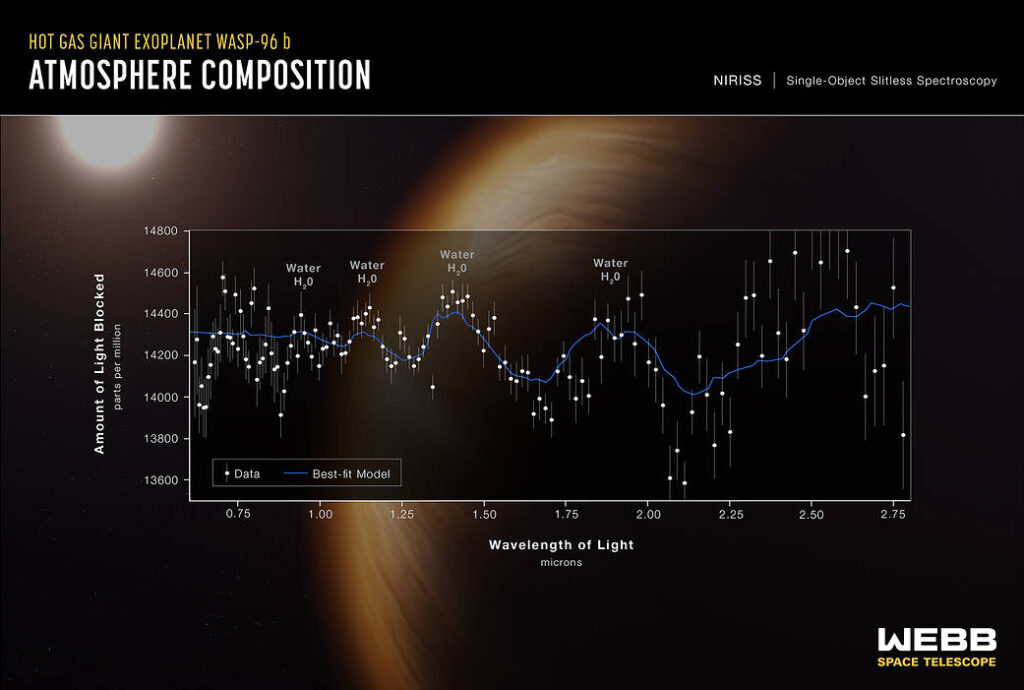One of the images captured by the James Webb Space Telescope and revealed by NASA this week pictures “the distinct signature of water, along with evidence for clouds and haze, in the atmosphere surrounding a hot, puffy gas giant planet orbiting a distant Sun-like star.”
NASA tells us that this planet, named “WASP-96 b,” is located “roughly 1,150 light-years” from us. That doesn’t sound so far, but it is. Light travels 5.88 trillion miles in a year. As a result, the planet we’re discussing is 6,762,000,000,000,000 miles from us. And it is just one of as many as ten trillion planets in the universe.
What does the unthinkable immensity and design of our universe say to our souls today?
Astrophysicist Jeff Zweerink notes: “The theory of the universe that we have” is “predicated on the idea that our universe ought to be understandable. It ought to be coherent. It ought to be the same out in the distant reaches of the universe as it is here.”
Then he observes, “That points to the Creator. That tells us something about the Creator.”
Philosopher William Paley (1743–1805) described a person walking through a forest who finds a watch. Would he assume it happened to exist by accident—that the hands, gears, and other parts fell from the sky and came together by coincidence? Or would he not assume that a watch requires a watchmaker?
How much more infinitely complex is the universe than a watch?
A leaf and a caterpillar
When God called my family to serve as pastor of First Baptist Church in Midland, Texas, I was thirty years old. They were a very large and significant congregation. I felt overwhelmed by the enormity of the opportunities and challenges before us.
Late one afternoon, I was sitting on our back porch, praying about our work and asking God for direction. A leaf blew across my foot, and I felt prompted to pick it up. I examined it in detail. As I became impressed with the intricacy of its design and considered the process by which trees turn soil, sunlight, and water into leaves and fruit, I sensed the Lord saying to me: “If I can design a leaf, I can design your life.”
And I felt his peace.
Many years later, God called our family from Atlanta to Park Cities Baptist Church in Dallas, Texas, as pastor. A few months after, I returned to Atlanta to perform the wedding of a dear friend’s daughter. I stayed at Ignatius House, a Jesuit retreat center on the Chattahoochee River that has come to be very special to me over the years.
That Saturday afternoon, I was sitting on a deck of the retreat center overlooking the river and considering what lay before us in Dallas. Once again, I felt overwhelmed by the enormity of this new ministry. Then my attention was drawn to a caterpillar inching its way along one of the railings of the deck. I watched the insect for a while as it made slow progress on its path.
The caterpillar had no idea I was there or that the river below was called the “Chattahoochee.” It had no concept of Ignatius House or of Jesuit spirituality. It was just doing what it was made to do on the plank where it found itself.
I sensed the Lord saying to me, “If I can design a caterpillar, I can design your life. Stay on the ‘plank’ where I have placed you, and I will lead you wherever you need to go.”
“Now I think we are small enough”
Theodore Roosevelt used to meet with a friend and naturalist named William Beebe for evening conversations. Then the two would go out on the lawn and search the night skies for a particular constellation.
Roosevelt would note, “That is the Spiral Galaxy of Andromeda. It is as large as our Milky Way. It is one of a hundred million galaxies. It consists of one hundred billion suns, each larger than our sun.”
Then he would say, “Now I think we are small enough. Let’s go to bed.”
Are you “small enough” to go to God today?



